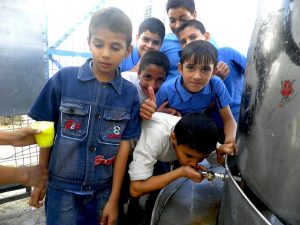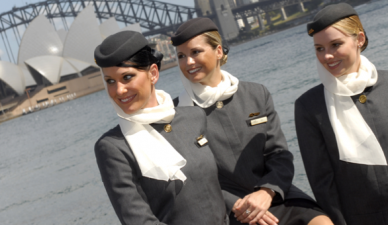 We speak to Mario Cucinella the architect behind Gaza’s eco schools about building under conflict, water, education and bringing hope to a desperate region
We speak to Mario Cucinella the architect behind Gaza’s eco schools about building under conflict, water, education and bringing hope to a desperate region
Early 2013 will see the launch of a green school which will collect rainwater and regulate internal temperature using thermal technologies. Whilst such a project would not be noteworthy in Europe, this project is coming to the energy-scarce, water-poor and conflict-ridden region of the Gaza Strip. Constructing a green building in such a region definitely comes with a whole cache of problems- it also comes with a whole load of benefits. Building green schools that save water and reduce the amount of energy needed offers huge benefits to the people of Gaza. I caught up with Mario Cucincella, the architect behind the project to find out more.
Aburawa: Looking back at the profile of your work, most of the projects you are involved in are based in Italy. How did you get involved in the scheme to bring eco schools to Gaza?
Cucinella: I got involved in this project as I was invited to a conference by the Italian government which was about the future of Palestine and how a green economy could help Palestine’s economy and encourage development. At that meeting I met with UNRWA which is the UN organisation for Palestinian refugees and we talked about presenting a project about the green buildings I had worked on in the last couple of years as they were interested in the integration between green issues and architecture.
They took me to visit refugee camps and we went to Gaza to see the schools and so I proposed to them an idea of building a different quality of school. I mean, UNRWA builds a lot of schools as they are in charge of education and health and social problems- so they build schools, hospitals and lots of other things- and there was a big programme to build one hundred schools in Gaza and they were really interested in a new style or standard of building. Well, these things grow very fast and they were excited about my proposals and I guess, here we are.
Aburawa: There has been lots of press attention around the concept of green schools- could you tell us about some of the green features of the Gaza schools?
Cucinella: Well as you know, Gaza has a real issue with access to lots of resources. So for example, water is really polluted and 40% of the population still don’t have access to potable water. There’s also significant energy blackout and so that does affect how you can run schools and hospitals. The first idea was to collect rainwater as they don’t collect rainwater and in Gaza there are between 100-600mm of water a square a year- which is not lot but it’s still free water. They also don’t recycle water so the principle is to be able to collect maximum water for the school.
The other issue is that the schools are very low quality and they are not suited to their environment. In the summer the buildings are very hot and it’s hard for children to focus on their studies when it’s 38 degrees in the classroom. So another important feature is creating a sufficient thermal mass so that energy is stored and temperature can be better regulated. These two are not very complex principles but when you put them together you get something quite special which can really improve the people’s quality of life. And that was the agenda behind these buildings.
 In Gaza it is notoriously difficult to construct buildings as there are issues around the ability to bring in materials due to the blockade. How will you be working around these restrictions to make sure the schools are built?
In Gaza it is notoriously difficult to construct buildings as there are issues around the ability to bring in materials due to the blockade. How will you be working around these restrictions to make sure the schools are built?
Cucinella: Well, it’s a complicated situation because as you know you can find almost any type of material in Gaza due to the tunnels but the problem is that the United Nations cannot buy anything from the black market. So everything has to come from Israel and that is slowing the process but we are hoping to make some of the materials in Gaza on site so that we can employ more people. But we will still need to bring in the pre-fabrication materials into Gaza before we can start.
In the last couple of months, the conflict between Gaza and Israel has flared up with both sides exchanging fire and a number of casualties in Gaza. How does this impact the progress of the schools?
Cucinella: This conflict has been going on now for more than forty years and sadly, you come to see the situation as the norm. It’s been like this for some time and there isn’t much you can do – the UN has been building schools and hospitals throughout the conflict and they accept that this is the situation that they are working in. There was a discussion at one stage about whether building green schools in a place where it is difficult to find food was a good idea but the thinking was that this is still very important. To design new schools and imagine a new life for the people of Gaza – it’s a different approach to humanitarian action. The project is also part of a programme of re-education with local engineers and also teaching the staff and pupils how to look after a green building. I mean giving schools free water and also the means to regulate the temperature are so important for the Gazan population.
We also hoping that our green approach will be part of the solution to the demographic boom in Gaza where people are struggling to build homes and schools with the resources they have. So, these (green buildings) are actually really useful for Gaza. Indeed, we are currently working with refugee camps in the West Bank around how we can improve the quality of life for people living in the camps. And how can we implement technologies such as solar panels and thermal technologies that help make them more autonomous from Israel.
What have the reactions been like to the project? Are they mostly negative or positive and has there been some reluctance to embrace the concept of a green school in the Middle East?
In the beginning it was a little difficult as people are naturally reluctant to change but after you explain the case and the changes that the school could have on the conditions the children study in, they recognise the benefits of the project. In fact when we presented the project at a conference I was surprised how optimistic and enthusiastic people were and they were saying if you can do this project in Gaza, you could do any project anywhere in the world! I mean we worry about this catastrophic vision of the world where there are no resources, no money, no energy and basically you don’t have to dream that in Gaza- it’s already like this. In a way, what I came away with is that the frugality of people is greater than any oppression – people are strong and are able to adapt to really difficult situations.
For me, it was also really exciting talking to the engineering students in Gaza – these people don’t really have any future, there is no work in Gaza and yet they go to school, they go to university and study engineering because they hope that something will change. For me, that was really inspiring. And I guess one day or another, this story of conflict will be finished. Maybe that day will be tomorrow or maybe it will be in another two hundred years but it will be over. Also when you are there you feel that the people of Gaza are more optimistic about their future than the people on the outside.
Who is the project financed by and when can we expect to see the first school to be opened?
The project is financed by the Islamic Development Bank but I also want to add that without UNRWA and the support of the General Commissioner, this project would have very difficult and almost impossible. We are going to Gaza in April and in the summer we are going to start construction so the first building should be open at the start of next year in 2013. It will be probably be six months of work. I think what’s really exciting about this project is that when you work in Europe, there is always a choice or another option, but when you deal with sustainable development in a place like Gaza it’s a real challenge. To be able to apply our knowledge and skills in a completely different region and see that it is really helpful is really inspiring.
For more on Green developments in Gaza see:
The Stunning Water Murals of Gaza (PHOTOS)
Boy Drowns in Sewage Water Basin in Gaza
Gaza’s Getting 20 Zero Emission Eco-Schools




Sir/Madam,
I wish to become part and parcle of Greens School.This is because Friends of the Earth Sierra Leone is an environmental organisation and we are working towards sound sustainable environment and development.My organisation is working with five primary and five secondary schools.I look forward working with you.Your cooperation is solicited.Kindly reply soonest.
Olatunde Johnson.
Great! interview, Arwa. I can’t wait to see this project get off the ground.
Really good questions and answers. I hope this is able to inspire other portions of the Gaza business (and residential) community to take notice of alternative building methods. As the saying goes “where there is a will, there is a way”. What I find a bit frustrating is that perhaps only thru the strife of Gaza has the Green School Architecture even been considered as an alternative where as areas of the world that do not have such obstacles turn a blind eye to such alternatives for whatever reason. Despite green building innovations in both materials and design the majority keep to “the old ways”.